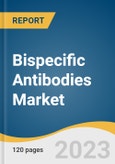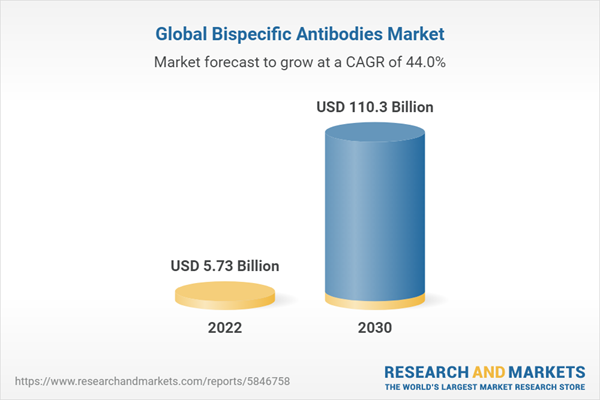The global bispecific antibodies market size is expected to reach USD 110.3 billion by 2030, expanding at a CAGR of 44.0% from 2023 to 2030, according to this report. The increasing prevalence of cancers such as breast cancer, lung cancer, prostate cancer, and other chronic diseases is a major driver for market growth. These molecules provide a targeted approach to treat specific types of cancer by simultaneously targeting cancer cells and the immune system. Additionally, the rising demand for personalized medicine and the shift toward targeted therapies have contributed to the market's growth.
Moreover, collaborations and partnerships between pharmaceutical companies and biotechnology firms have played a crucial role in advancing bispecific antibody research and development. These collaborations have accelerated the discovery and clinical development of novel bispecific antibodies, further propelling the market growth. For instance, in January 2022, Amgen and Generate Biomedicines established a research partnership agreement to discover and develop protein therapies for five clinical targets spanning different therapeutic areas and modalities. In addition to it, in May 2023, The U.S. FDA approved EPKINLY (epcoritamab-bysp) as the inaugural bispecific antibody to be authorized for the treatment of relapsed or refractory Diffuse Large B-Cell Lymphoma (DLBCL) in adult patients.
The COVID-19 pandemic has had a dual impact on the bispecific antibodies industry. On one hand, it has underscored the significance of bispecific antibodies in addressing infectious diseases. However, the pandemic has also introduced challenges in the form of supply chain disruptions, leading to delays in the research and development of bispecific antibodies. Furthermore, economic uncertainties and budget constraints have affected research institutions and biotech companies, potentially influencing their prioritization and allocation of resources towards bispecific antibody development.
Furthermore, various developments undertaken by participants, and increasing industry-academia collaborations have driven the global market to a significant extent. For instance, in March 2023, Thermo Fisher Scientific Inc collaborated with Arsenal Bioscience, a cell therapy company to facilitate and support the clinical manufacturing of Autologous T-Cell Therapies.
Moreover, collaborations and partnerships between pharmaceutical companies and biotechnology firms have played a crucial role in advancing bispecific antibody research and development. These collaborations have accelerated the discovery and clinical development of novel bispecific antibodies, further propelling the market growth. For instance, in January 2022, Amgen and Generate Biomedicines established a research partnership agreement to discover and develop protein therapies for five clinical targets spanning different therapeutic areas and modalities. In addition to it, in May 2023, The U.S. FDA approved EPKINLY (epcoritamab-bysp) as the inaugural bispecific antibody to be authorized for the treatment of relapsed or refractory Diffuse Large B-Cell Lymphoma (DLBCL) in adult patients.
The COVID-19 pandemic has had a dual impact on the bispecific antibodies industry. On one hand, it has underscored the significance of bispecific antibodies in addressing infectious diseases. However, the pandemic has also introduced challenges in the form of supply chain disruptions, leading to delays in the research and development of bispecific antibodies. Furthermore, economic uncertainties and budget constraints have affected research institutions and biotech companies, potentially influencing their prioritization and allocation of resources towards bispecific antibody development.
Furthermore, various developments undertaken by participants, and increasing industry-academia collaborations have driven the global market to a significant extent. For instance, in March 2023, Thermo Fisher Scientific Inc collaborated with Arsenal Bioscience, a cell therapy company to facilitate and support the clinical manufacturing of Autologous T-Cell Therapies.
Bispecific Antibodies Market Report Highlights
- By indication, the cancer segment dominated the market with a share of 70.4% in 2022, due high prevalence of cancer globally. Furthermore, bispecific antibodies specifically target tumor cells or tumor-associated antigens while sparing healthy cells
- Inflammatory and autoimmune disorders segment is expected to grow at a significant CAGR of 35.7% during 2023-2030, owing to the increasing adoption and development of bispecific antibody drugs for the treatment of rheumatoid arthritis, psoriasis, Crohn's disease, and multiple sclerosis among others.
- North America established a strong regional position in the global market with an 89.5% share in 2022 due to its highly developed healthcare infrastructure and favorable government policies
Table of Contents
Chapter 1. Methodology and Scope
Chapter 2. Executive Summary
Chapter 3. Market Variables, Trends, & Scope
Chapter 4. Indication Business Analysis
Chapter 5. Regional Business Analysis
Chapter 6. Competitive Landscape
List of Tables
List of Figures
Companies Mentioned
- Amgen
- Roche
- Genentech
- Akeso, Inc
- Janssen
- Taisho Pharmaceutical
- Immunocore
Methodology

LOADING...
Table Information
| Report Attribute | Details |
|---|---|
| No. of Pages | 120 |
| Published | June 2023 |
| Forecast Period | 2022 - 2030 |
| Estimated Market Value ( USD | $ 5.73 Billion |
| Forecasted Market Value ( USD | $ 110.3 Billion |
| Compound Annual Growth Rate | 44.0% |
| Regions Covered | Global |
| No. of Companies Mentioned | 7 |









